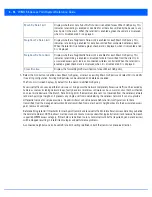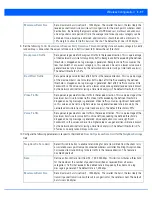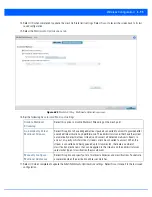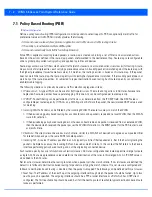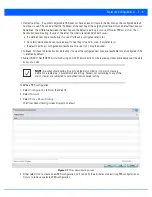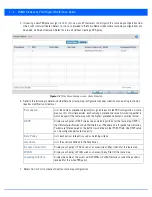
6 - 98 WiNG 5.6 Access Point System Reference Guide
11. Set the following
From Air Upstream Random Early Detection Threshold
settings for each access category:
12. Configure the following parameters in respect to the intended
To Air Downstream Rate Limit,
or traffic from a controller
to associated access point radios and the wireless client:
13. Set the following
To Air Downstream
Random Early Detection Threshold
settings for each access category:
Background Traffic
Set a percentage value for background traffic in the transmit direction. This is a
percentage of the maximum burst size for low priority traffic. Background traffic exceeding
the defined threshold is dropped by the client and a log message is generated. The default
threshold is 50%.
Best Effort Traffic
Set a percentage value for best effort traffic in the transmit direction. This is a percentage
of the maximum burst size for normal traffic. Best effort traffic exceeding the defined
threshold is dropped by the client and a log message is generated. The default threshold
is 50%.
Video Traffic
Set a percentage value for video traffic in the transmit direction. This is a percentage of
the maximum burst size for video traffic. Video traffic exceeding the defined threshold is
dropped by the client and a log message is generated. The default threshold is 25%.
Voice Traffic
Set a percentage value for voice traffic in the receive direction. This is a percentage of the
maximum burst size for voice traffic. Voice traffic exceeding the defined threshold is
dropped by the client and a log message is generated. The default threshold is 0%. 0%
implies no early random drops will occur.
Neighbor Tx Rate Limit
Select this radio button to enable rate limiting for data transmitted from connected
wireless clients. Enabling this option does not invoke rate limiting for data traffic in the
transmit direction. This feature is disabled by default.
Rate
Define a receive rate limit from 50 - 1,000,000 kbps. This limit constitutes a threshold for
the maximum the number of packets transmitted or received by the client. Traffic that
exceeds the defined rate is dropped and a log message is generated. The default rate is
1,000 kbytes.
Maximum Burst Size
Set a maximum burst size from 2 - 64 kbytes. The smaller the burst, the less likely the
receive packet transmission will result in congestion for the wireless client. The default
burst size is 64 kbytes.
Background Traffic
Set a percentage value for background traffic in the receive direction. This is a percentage
of the maximum burst size for low priority traffic. Background traffic exceeding the defined
threshold is dropped by the client and a log message is generated. The default is 50%.
Best Effort Traffic
Set a percentage value for best effort traffic in the receive direction. This is a percentage
of the maximum burst size for normal traffic. Best effort traffic exceeding the defined
threshold is dropped by the client and a log message is generated. The default is 50%.
Video Traffic
Set a percentage value for video traffic in the receive direction. This is a percentage of the
maximum burst size for video traffic. Video traffic exceeding the defined threshold is
dropped by the client and a log message is generated. The default is 25%.
Voice Traffic
Set a percentage value for voice traffic in the receive direction. This is a percentage of the
maximum burst size for voice traffic. Voice traffic exceeding the defined threshold is
dropped by the client and a log message is generated. The default threshold is 0%.0%
means no early random drops will occur.
Summary of Contents for WiNG 5.6
Page 1: ...Motorola Solutions WiNG 5 6 ACCESS POINT SYSTEM REFERENCE GUIDE ...
Page 2: ......
Page 22: ...8 WiNG 5 6 Access Point System Reference Guide ...
Page 26: ...1 4 WiNG 5 6 Access Point System Reference Guide ...
Page 38: ...2 12 WiNG 5 6 Access Point System Reference Guide ...
Page 74: ...3 36 WiNG 5 6 Access Point System Reference Guide ...
Page 468: ...6 2 WiNG 5 6 Access Point System Reference Guide Figure 6 1 Configuration Wireless menu ...
Page 568: ...6 102 WiNG 5 6 Access Point System Reference Guide ...
Page 614: ...7 46 WiNG 5 6 Access Point System Reference Guide ...
Page 660: ...8 46 WiNG 5 6 Access Point System Reference Guide ...
Page 716: ...9 56 WiNG 5 6 Access Point System Reference Guide ...
Page 730: ...10 14 WiNG 5 6 Access Point System Reference Guide ...
Page 982: ...14 20 WiNG 5 6 Access Point System Reference Guide ...
Page 984: ...A 2 WiNG 5 6 Access Point System Reference Guide ...
Page 1046: ...B 62 WiNG 5 6 Access Point System Reference Guide ...
Page 1047: ......











